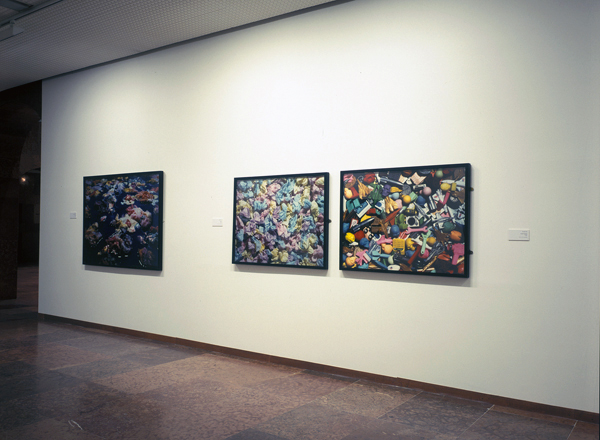This exhibition was selected as a Circulating Exhibition and is not designed as a history of constructed photography in Britain. All the selected work was produced between 1988-1991 and links a number of artists interested in the traditions of picture-making - from 'tableaux vivants' and 'history painting' to still life, collage and montage - and whose innovative use of the camera blurs the distinction between 'pictures' and photography. The show consists of 27 works by 10 artists - Keith Arnatt, Ron O'Donnell, Lea Andrews, Hannah Collins, Boyd Webb, Helen Sear, Mari Mahr, Tim Head, Calum Colvin and Helen Chadwick.
One of the common threads of the exhibitions is a concern with environmental issues. Keith Arnatt's Objects from a rubbish dump, 48" square each, are reflections on the nature of the 'Picturesque' - the debris of an industrialised society enlarged almost beyond recognition to assume a synthetic beauty of its own. Tim Head, Ron O'Donnell and Calum Colvin also explore the relationship between surfeit and decay, wringing contemporary meaning from some of the most hallowed compositional devices (e.g. Ron O'Donnell's Adam and Eve, modelled after Cranach, with a 'mates' carrying putto suspended between the nude male and female, and all in a modern garden of earthly delights). Helen Chadwick's Meat Abstracts take the idea of abundance to mannerist conclusions, recalling Caravaggio in her starkly lit tableaux of giblets swagged in satin, livers and lights on platters of unplucked skin.
References to the history of the composition of images are pervasive.
Lea Andrews, one of the youngest artists in the exhibition, invents a history for the post-war housing estate in Sonning-on-Thames on which he was brought up. In his triptych, Public Sculpture, Private Land he creates a full-scale war memorial and equestrian monument out of photographic print, erects these in a blank shopping parade, and re-photographs the scene. Helen Sear, a young Cardiff artist, examines the 'museumification' of images. Much of her work is a consolidation of earlier installation work, the photographs constructed by re-photographing projected slides, sometimes several exposures on one negative. The imagery, of glass-cased birds and rodents brought into natural daylight, and interiors drowned in reflected light, recreate the frozen moment at which an image is caught and held. Ron O'Donnell excavates archaeological myth in his Bed of Osiris, a corner of his Leith studio forever Egypt, painted as the burial chamber of the God Osiris and photographed with a lead-lined bed of earth in the centre, sprouting ears of corn and the genitals of the hapless God, whose other parts were dispersed to the four corners of the earth.
Another common thread is the large scale of the exhibits. Naturally dramatic, the large format celebrates the camera's ability to exploit technological advances in a manner less appropriate to the more traditional fine arts. From the confident use of computer programming (as in the large cibachromes of Boyd Webb) to the exquisite silver gelatine printing on a colossal scale employed by Hannah Collins, these works demonstrate that technical innovation married to a firm grasp of the fundamentals of picture-making can create a wholly original format in which to carry modern meaning.

